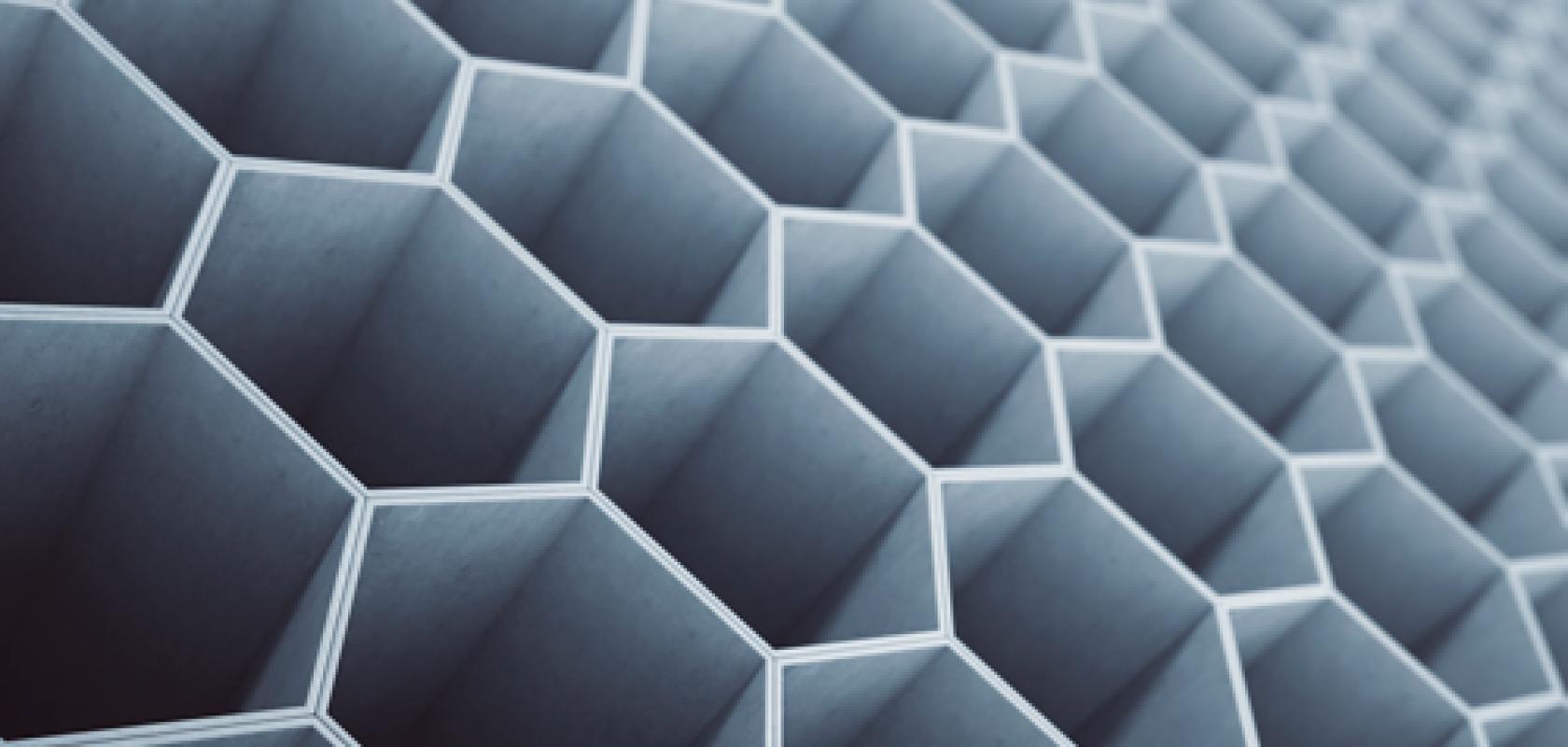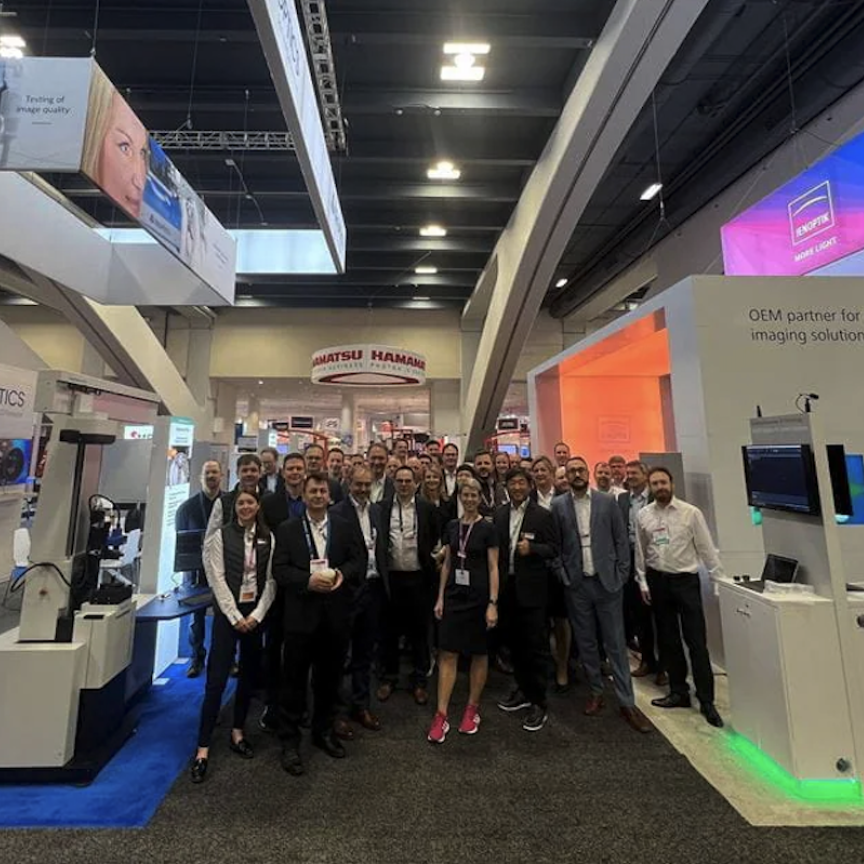In the early 19th century, Daniel Colladon’s fountain of light established the core principles of modern optical fibre: light trapped by total internal reflection followed the curved path of a water jet, thus illuminating the water for an audience.
Similarly, modern optical fibres comprise a solid core surrounded by a transparent cladding material with a refractive index lower than that of the core. The light stays in the core by total internal reflection, which causes the fibre to act as a waveguide.
But solid optical fibre requires a large core to transmit higher power, which gives undesirable physical properties. Thin fibre bends because the glass at the core is very thin; but as it gets thicker it behaves less like a fibre and more like a glass rod. In the 1990s, Phillip St J Russell pioneered a microstructured photonic crystal fibre (PCF) as an alternative.
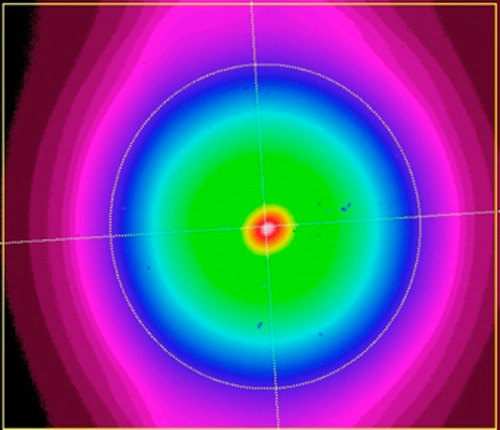
PCF Fibre output, showing bimodal behaviour. (Image: Gooch & Housego)
PCF guides light by confining it within an array of microscopic air holes that run along the entire length of a fibre. The core provides a waveguide for the trapped light, with the photonic crystals forming a cladding around the core. There are also versions in which the light is confined in a core with a lower index than the cladding – these fibres can even have a hollow core.
The tuneable refractive index and refractive index contrast means the new technology allows for a wider range of optical properties than are possible in standard optical fibres. Nonlinear effects can be adjusted to select specific properties: for amplification, light can be more strongly confined in polarisation-maintaining fibres; or a hollow core can be used to propagate wavelengths that would be absorbed by standard fibre materials.
One of the fastest growing applications of PCF is use in high-power fibre lasers and amplifiers. Scientists and engineers are working to incorporate these advanced materials into fibre lasers for industrial use and more specialised applications.
Stacks of spaghetti
The Fraunhofer Institute for Applied Optics and Precision Engineering IOF in Jena, Germany, holds fibre laser performance records, using fibres developed jointly with PCF pioneer NKT Photonics. This summer, Fraunhofer IOF opened a new PCF facility with the mission of conducting application-oriented research while producing its own fibres.
An ordinary optical fibre starts with a ‘preform’, or a thick segment of silica comprising an inner core and outer cladding designed to have a specific refractive index. The preform is loaded at the top of a fibre drawing tower. Here, its tip gets melted until a molten segment falls down due to gravity, thus elongating and solidifying into a thin fibre as it cools.
‘You take the large chunk of glass, heat it, and it becomes thinned out like a piece of cheese would,’ said Falk Eilenberger, research coordinator at Fraunhofer IOF. The composition of the preform is preserved in the final fibre.
That’s a straightforward process for a solid piece of glass – but it’s more difficult for PCF, where high-pressure gasses are needed to prevent the holes from collapsing. ‘That’s totally feasible. But the difficult question is how to get a preform that has holes,’ added Eilenberger.
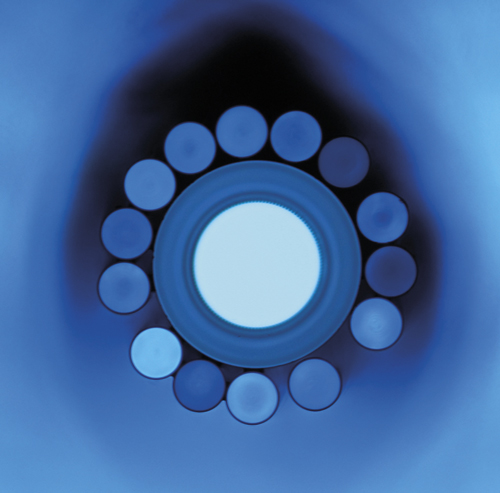
Hollow core fibre. (Image: Fraunhofer IOF)
He explained how stacking patterns of smaller silica rods ‘that look like spaghetti’ leads to a preform with a microarray of holes. Heating and elongating the resulting structure, as with solid core fibres, makes the ‘adjacent small spaghettis fuse together, with holes where you left out the rods. In this way, you can very much define the geometry and light-guiding properties of the fibre’.
Fraunhofer develops continuous wave lasers that emit on the order of a kilowatt from a single fibre, for use in any material processing application such as cutting or welding. They also develop ultrashort pulse fibre lasers, delivering pulses of up to a kilowatt for a few hundred femtoseconds. Light-matter interaction at the femtosecond scale offers new opportunities for material processing, as well as a tool to study new modes of light-matter interaction.
While Fraunhofer’s immediate goals for PCF are to improve efficiency and reduce energy consumption in industrial production, Eilenberger speaks excitedly about longer-term goals. Ultrashort pulse lasers could be developed into a tabletop particle accelerator, bringing with it treatments for certain cancers, while continuous wave systems could be used as a ‘laser cannon’ to launch microsatellites into space. Then, a powerful earth-based laser could guide the satellite by illuminating an attached sail.
Handling difficult fibre
PCF affords unprecedented precision for controlling the fibre’s refractive index profile by manipulating the core and cladding; still, the fibre itself is notoriously difficult to manage. Standard splicing, mode-stripping and end-cap procedures for optical fibres typically don’t work with PCF. Gooch & Housego builds on its experience managing optical fibre in high stress applications to offer enterprising ways around the inherent challenges.
Gooch & Housego’s Torquay facility specialises in design and manufacture of fibre optic components for use in harsh environment applications, including space and undersea telecommunications. PCF fits this niche, because ‘we’re good at handling difficult fibre’, said product manager Una Marvet. High reliability requires that fibre operations are carried out with a high degree of precision and repeatability. Similarly, when a lot of power propagates through a fibre, deficiencies in process or manufacturability can have disastrous consequences, so it’s important to understand how to manage and connect fibre properly.
PCF can be difficult to manage because the hole pattern changes the physical properties of the fibre, as well as the optical properties. Splicing, or joining pieces of fibre by melting them together, has to be done such that the hole pattern is maintained in both fibres, while still producing a strong enough join. Similarly, fibre amplifiers require that pump light, which propagates in the cladding, be removed by a process called mode-stripping. It can be difficult to do this without affecting the fibre core. In addition, joining standard fibre to PCF presents challenges because of the different relationship between physical geometry and optical behaviour, making mode matching difficult.
Gooch & Housego holds a patent for splicing specialised fibre, which is applicable to PCF.
‘PCF is similar to the first commercial lasers: it’s a solution looking for a problem,’ said Marvet. But their microstructuring offers infinite opportunities, where standard fibres are limited by the properties of the solid medium.
Making connections
French optics and laser technology centre Alphanov offers a comprehensive line of connectors for joining hollow-core and large area PCF. It, too, partners with leading PCF supplier NKT Photonics, and addresses the interfacing needs of NKT’s entire product line as well as other manufacturers.
‘It’s not easy to find a process to cleave and splice and add an end cap, without jeopardising the microstructure and beam quality of the laser going through the fibre,’ said Alexandre Loulier, Alphanov engineer.
Alphanov helps clients to reach innovative solutions for specific applications. As an example, the centre has developed a connector for hollow core PCF, which can handle the powerful pulses of a femtosecond laser. The fibre may be useful for beam delivery during micromachining with ultrashort pulse lasers; but connectors are not available off-the-shelf.
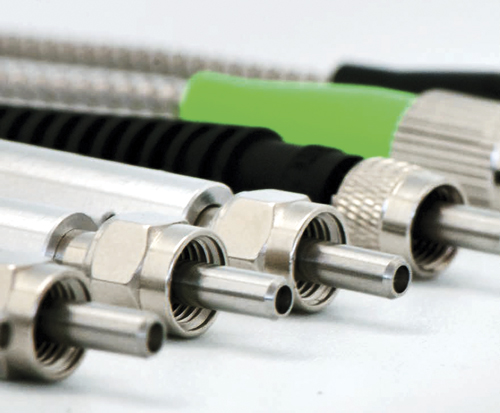
PCF connectors. (Image: Alphanov)
Alphanov also develops adaptors for splicing fibres with different mode field diameters, such as injecting a single mode fibre laser (10µm) into a 40µm PCF. ‘This is how you play with PCF to build what you want,’ said Loulier. These tools have led them to develop a fibre amplifier using a mode fill adapter to improve efficiency. The larger core allows for more power to propagate at a single mode with no loss.
When PCF came along some 20 years ago, it was not industrial-grade, but was made especially for scientists. Today, NKT offers an industrial line of PCF that can be used with more powerful lasers at different wavelengths. ‘Alphanov transforms any PCF into a patch-cable that is useable for everyone, for every industry, as any standard fibre,’ added Loulier.
State-of-the-art sensors
While high power lasers are a prominent PCF application, the fibres have garnered interest in passive sensing applications. They take advantage of the large index contrast between core and cladding.
‘The PCF looks similar, superficially. But sensing fibres will not contain any active materials, like fluorescent material that you can pump and lase at certain wavelength. And they’ll have smaller core areas,’ said Fraunhofer’s Eilenberger.
In recent decades, photonic biosensors have attracted attention because they can characterise components in a biological sample, based on label-free optical tools. Now, scientists are combining PCF technology with plasmonic science to achieve the highest sensitivity and best detection accuracy.
Surface plasmon resonance (SPR) uses the property that a thin layer of metal (gold, silver, copper, aluminium, etc) on a high refractive index glass surface can absorb laser light, producing electron waves or ‘surface plasmons’ on the plasmonic metal surface. If a mobile molecule – an analyte – binds to a receptor on the metal surface, the refractive index of the metal film changes and can be detected in light reflected from the surface. Depositing the metal film onto PCF, instead of conventional optical fibre, offers a more flexible design because of a large index contrast between core and cladding. Here, SPR phenomenon can be easily observed.
In a collaboration between the Australian National University and the University of Birmingham, Rajib Ahmed and Ahmmed Rifat proposed a simple PCF biosensor design in which chemically stable gold is deposited on the outer surface of the PCF. ‘External metal coated PCF sensors are more feasible from the fabrication point of view, compared to the internal metal coated sensors,’ said Rifat. The unknown analyte is simply flowed across the outer surface of metal layer, and detected by the resonance wavelength shift (either red or blue shift).
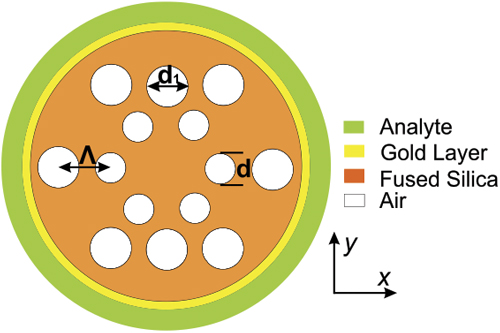
Cross-section view of proposed PCF biosensor. (Image: Rifat et al. J Nanophotonics)
Ahmed and Rifat are developing a sensor in the refractive index range common to most biological molecules (1.33 to 1.37). The proposed design will reduce fabrication complexity compared to existing sensors, and models suggest it can achieve superior sensitivities. When fabricated, they hope it will find the broad range of applications, such as medical diagnostics, biochemical, environmental monitoring and food safety.
PCF is one of the most active fields of current optics research. While yet to find a foothold in the mainstream industry, these specialised optical fibres offer a diverse and growing range of applications that will drive future markets.

